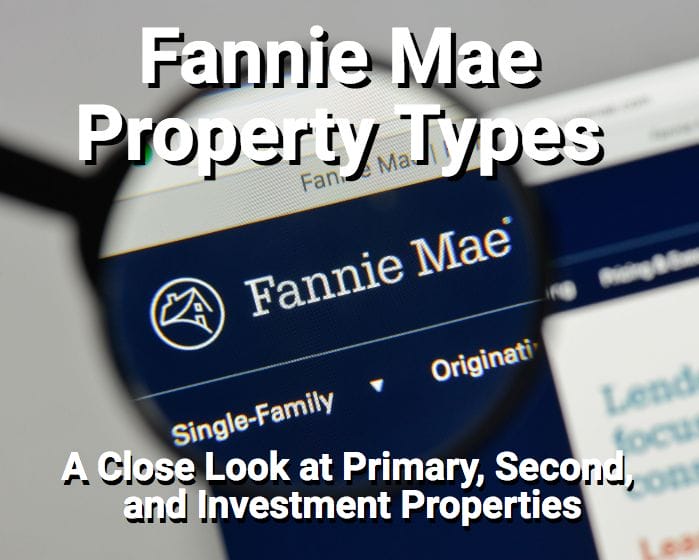Fannie Mae is an important part of the American real estate market. This government-backed company doesn’t provide loans, but instead purchases mortgage loans from lenders, which can include banks, credit unions, and mortgage companies. The company holds mortgages as an investment and cycles back available capital back into real estate market.
In order for mortgages to be purchases by Fannie Mae, they must meet certain conditions. However, the criteria for each type is not always the same, so the type of property you have can make a profound difference on the terms of your loan.
Fannie Mae Rules for Various Property Types
Why Does Property Type Matter?
In order to keep risk low while providing support for the real estate market, Fannie Mae provides different terms and conditions for each type of real estate. For example, the allowable loan-to-value (LTV) ratio is adjusted with each property type. The type that has the highest available LTV is a principle residence, which has a 97% maximum LTV on fixed-rate mortgages. This essentially means you can borrow up to 97% of the property value and will only need a 3% downpayment. The lowest is cash-out refinancing for a multiunit property (up to four units), which has a maximum LTV of only 70%, meaning you’ll have to generate the remaining 30%.
To see specifics on how property type affects the loan, see Fannie Mae’s Eligibility Matrix.
Principle Residence
The first, and probably the most common type of home that Fannie Mae works with, is the principle residence. Simply put, this is the home you live in, so if you’re a typical homeowner who lives in the house with your family, and you don’t split your time between another home, defining your property as a principle residence should be straightforward.
However, if you own multiple homes, there may be complexities in determining which location is your primary residence. As Fannie Mae says, this is the “property that the borrower occupies as his or her primary residence.” That may not be extremely helpful, but there are conditions that determines whether a residence is a principle residence even when the borrower is not occupying the property.
For multiple owners, only one borrower needs to occupy and take title of the property for it to be a “primary residence,” unless there are other requirements for mortgages that have guarantors of co-signers. If that is the case, you will need to consult Fannie Mae’s guidelines to sort out the complexities.
If the borrower is a parent or legal guardian who wants to provide housing for a disabled or handicapped child, there will need to be specific requirements for a loan supported by Fannie Mae. The child must be unable to work and not have sufficient income to qualify for a loan on their own. In this case, the parent or guardian is considered the owner/occupant.
Sons and daughters wanting to provide housing for parents are also eligible for Fannie Mae support. Essentially, the same system applies but in reverse; the parent must be unable to work and unable to support a loan with their current income. If this requirement is met, the child is considered the owner/occupant.
Fannie Mae also provides terms and conditions for property used as a group home, but someone will need to occupy the home as a primary residence.
Second Home
If you are seeking a second home, you have many lending options available, including Fannie Mae support. However, you will need to make sure the property and the organization meets specific requirements.

To qualify as a second home according to Fannie Mae, you must live in the property for “some portion of the year.” Exactly how that portion is determined will depend on other factors, so discuss this with a Fannie Mae representative or a mortgage expert for more details.
For second homes as defined by Fannie Mae, the property must be a one-unit dwelling. Fannie Mae does provide support for duplexes and other multiunit properties, but these are ineligible for qualification as second homes. Similarly, it must not be a rental property of any type, even if it is a single-unit residence, and it can’t be a timeshare agreement.
The home must also be suitable for year-round occupancy, so if you could not, for example, live in your Minnesota lakeside cabin during the winter because of no heat or insulation, it would not qualify.
You, as the borrower, must also have exclusive control of the property. Essentially, this just means that no one else can say when and how the property is used.
Finally, to be classified as a second home, there cannot be any legal agreements that give control of occupancy to a management firm. This is tied to the restriction on both rental and timeshare properties.
If there is rental income from the property, the loan is still eligible for delivery as a second home, but the income cannot be used for qualification purposes, and all other requirements will need to be met, including the requirements for occupancy. This essentially means that you may be able to qualify the loan as a second home and rent it out on occasion as a vacation rental, but you will have to live in the home for some time through the year.
Investment Properties
Fannie Mae will classify an investment property as something that is owned by you but not occupied by you in any fashion. A Loan-Level Price Adjustment (LLPA), which adjusts the mortgage cost, will be applied to any loan on an investment property. This will come in addition to any adjustments that are applicable for any other reason.
For details on how an LLPA will affect your loan, see Fannie Mae’s LLPA matrix or consult a mortgage professional.
In most cases, eligibility and pricing for group homes under the investment property category will be the same as for established standards for second home and owner-occupied properties.
Providing Dedicated Support for Fannie Mae Loans
If you want more information on your loan options, contact San Diego Purchase Loans today. We’ll show you the details of Fannie Mae property qualifications so you can find the right loan for your primary residence, second home, or investment property.


